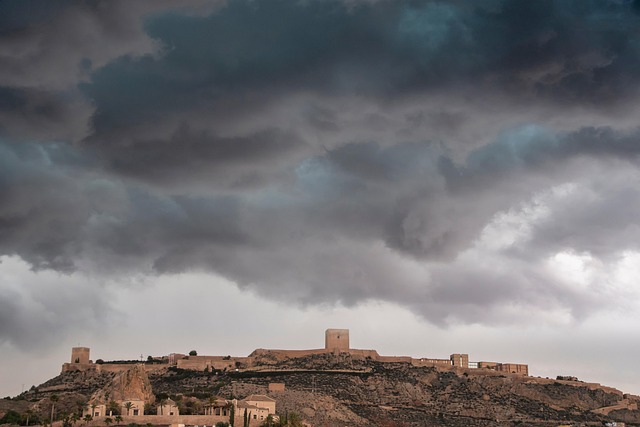By 2025, Karachi, Pakistan's economic center, will confront intensified meteorological challenges due to climate change, including more frequent and severe storms, flash floods, and unpredictable rainfall patterns. Advanced weather forecasting technology leveraging high-resolution satellite imagery, computational power, and sensor networks will enable precise storm tracking, enhancing safety through timely warnings. Urban planners and policymakers must adopt proactive strategies, such as improved infrastructure, early warning systems, emergency preparedness, and green spaces, to bolster Karachi's resilience against these dynamic changes.
In 2025, understanding storm tracks and weather fronts takes on new urgency, especially for cities like Karachi facing evolving weather patterns. This article delves into the intricate dynamics of global storm tracks, examining their impact on local climates, particularly in Karachi. We explore the unique meteorological challenges the city encounters, highlighting advancements in weather forecasting technology that aid in dynamic storm tracking. Additionally, we discuss potential climate change impacts and offer preparedness strategies to enhance resilience in face of shifting weather fronts.
- Understanding Storm Tracks and Weather Fronts: A Global Perspective
- The Unique Meteorological Challenges of Karachi in 2025
- Advancements in Weather Forecasting Technology for Dynamic Storm Tracking
- Potential Impacts of Climate Change on Storm Behavior and Front Shifts
- Preparedness and Resilience Strategies for Cities Like Karachi in Face of Evolving Weather Patterns
Understanding Storm Tracks and Weather Fronts: A Global Perspective

Storm tracks and weather fronts play a pivotal role in shaping global climate patterns, with their movements influencing local weather conditions across continents, including Karachi. These dynamic systems are essentially pathways along which storms and cold or warm fronts travel, providing crucial insights into atmospheric behavior. Weather fronts represent boundaries between masses of air with distinct characteristics—temperature, humidity, and pressure—and they often initiate changes in the atmosphere’s stability, leading to various meteorological phenomena.
On a global scale, understanding storm tracks is essential for forecasting weather patterns. In 2025, advancements in meteorological technology will likely enhance our ability to predict these tracks more accurately. Karachi, situated along the Arabian Sea coast, experiences significant influences from the Indian Ocean’s monsoons, which are closely tied to shifting storm tracks and fronts. This knowledge of global weather systems is instrumental in preparing for potential extreme weather events and enabling communities like Karachi to adapt and mitigate risks effectively.
The Unique Meteorological Challenges of Karachi in 2025

Karachi, Pakistan’s economic powerhouse, faces distinct meteorological challenges in 2025, adding complexity to its urban dynamics. With a projected increase in extreme weather events due to climate change, the city’s vulnerability is heightened. The unique geography of Karachi, nestled between the Arabian Sea and the mountains, creates microclimates that can spawn sudden, intense storms and changing weather fronts. These phenomena are further exacerbated by the urban heat island effect, where concrete jungles absorb and retain heat, influencing local wind patterns and humidity levels.
In 2025, Karachi’s residents may witness more frequent and severe storms, with potential impacts on infrastructure and daily life. Shifting front lines between weather systems could lead to unpredictable rainfall patterns, causing flash floods in low-lying areas. Understanding these challenges is crucial for urban planners and policymakers to adapt strategies, enhance weather forecasting accuracy, and build resilience in Karachi’s ever-evolving landscape.
Advancements in Weather Forecasting Technology for Dynamic Storm Tracking

Advancements in weather forecasting technology are transforming storm tracking, particularly in dynamic and diverse regions like Karachi. In 2025, sophisticated models and instruments enable meteorologists to predict storm movements with unprecedented accuracy. These improvements leverage high-resolution satellite imagery, advanced computational power, and real-time data from a dense network of sensors and weather stations across the city.
Such technological leaps allow for more precise identification and monitoring of storm fronts as they shift and evolve. This enhanced capability is crucial for Karachi, where frequent and intense storms can pose significant challenges to urban infrastructure and residents. Accurate tracking enables timely warnings, facilitating proactive measures for disaster mitigation and ensuring public safety.
Potential Impacts of Climate Change on Storm Behavior and Front Shifts

Climate change, a pressing global concern, is expected to significantly influence storm behavior and frontal shifts in 2025, particularly in metropolitan areas like Karachi. Rising temperatures can lead to more intense and frequent storms, with potential impacts on local communities and infrastructure. Warmer air holds more moisture, often resulting in heavier rainfall and increased flooding risks, challenges that Karachi, situated along the coast, may face more acutely.
Additionally, changing wind patterns associated with climate change might alter storm tracks, causing shifts in frontal systems. These shifts can disrupt traditional weather patterns, leading to unseasonal storms or prolonged periods of dryness. Such dynamic changes could significantly affect agricultural practices and water resource management in the region, underscoring the need for adaptive strategies in Karachi and similar coastal cities worldwide.
Preparedness and Resilience Strategies for Cities Like Karachi in Face of Evolving Weather Patterns

With evolving weather patterns, cities like Karachi face increasing challenges from storm track changes and shifting fronts. To enhance preparedness and resilience, urban planners and policymakers must adopt a multi-faceted approach. This includes strengthening infrastructure to withstand extreme weather events, such as upgrading drainage systems and building resilient coastal defenses against rising sea levels and intense storms.
Additionally, integrating early warning systems and improving emergency response capabilities are vital. Educating citizens about potential risks, evacuation procedures, and emergency preparedness kits can significantly enhance community resilience. Karachi, known for its bustling metropolis, must also focus on developing green spaces and urban forests to mitigate the urban heat island effect and improve air quality, thereby enhancing overall climate adaptability.
By 2025, Karachi’s unique meteorological challenges will demand enhanced preparedness in the face of evolving storm tracks and shifting weather fronts. Advancements in weather forecasting technology, coupled with a deeper understanding of global climate patterns, offer critical tools for predicting dynamic storm behavior. In light of these changes, implementing resilience strategies is essential to safeguard communities and infrastructure in cities like Karachi. Such measures will be pivotal in mitigating potential impacts of climate change and ensuring the city’s adaptability to future weather conditions.
